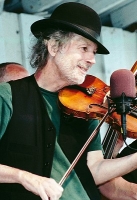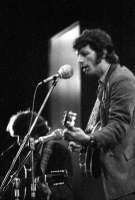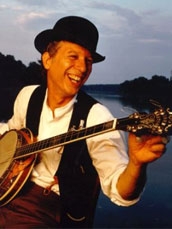John Hartford Biography

John Cowan Hartford was an American folk, country and bluegrass composer and musician known for his mastery of the fiddle and banjo, as well as for his witty lyrics, unique vocal style, and extensive knowledge of Mississippi River lore. Hartford performed with a variety of ensembles throughout his career, and is perhaps best known for his solo performances where he would interchange the guitar, banjo, and fiddle from song to song. He also invented his own shuffle tap dance move, and clogged on an amplified piece of plywood while he played and sang.
His early musical influences came from the broadcasts of the Grand Ole Opry in Nashville, and included Earl Scruggs, nominal inventor of the three-finger bluegrass style of banjo playing. Hartford said often that the first time he heard Earl Scruggs pick the banjo changed his life. By age 13, Hartford was an accomplished old-time fiddler and banjo player, and he soon learned to play guitar and mandolin as well. Hartford formed his first bluegrass band while still in high school at John Burroughs School. After high school he enrolled at Washington University, completed 4 years of a commercial arts program and dropped out to focus on his music, however he did later receive a degree in 1960. He immersed himself in the local music scene, working as a DJ, playing in bands, and occasionally recording singles for local labels. In 1965, he moved to Nashville, the center of the country music industry. In 1966, he signed with RCA Victor, and produced his first album, Looks at Life, in the same year.
In 1967, Hartford's second album Earthwords & Music spawned his first major hit, "Gentle On My Mind." His recording of the song was only a modest success, but it caught the notice of Glen Campbell, who recorded his own version, which gave the song much wider publication. At the 1968 Grammies, the song netted four awards, two of which went to Hartford; just as importantly, it became one of the most widely recorded country songs of all time, and the royalties it brought in allowed Hartford great financial independence; Hartford would later say that the song bought his freedom. As his popularity grew, he moved to the West Coast, where he became a regular on the "Smothers Brothers Comedy Hour"; other television appearances followed, as did recording appearances with several major country artists. The success on "SmoBro" was enough that Hartford was offered the lead role in a TV detective series but he turned it down to move back to Nashville and concentrate on his music. He also was a regular on Campbell's and Johnny Cash's television shows.

During the years 1968-1970, Hartford recorded four more albums for RCA: The Love Album, Housing Project, John Hartford, and Iron Mountain Depot. In 1971, He moved over to Warner Bros. Records, where he was given more freedom to record in his untraditional style. There, fronting a band that included Vassar Clements, Tut Taylor and Norman Blake, he recorded several albums that set the tone of his later career, including the acclaimed Aereo-Plain and Morning Bugle. Of the former, Sam Bush said "Without Aereo-Plain (and the Aereo-Plain band), there would be no newgrass music."
Switching several years later to the Flying Fish label, Hartford continued to participate in the experimentation with nontraditional country and bluegrass styles that he and artists such as Bush were engaging in at the time. Among his recordings were two albums in 1977 and 1980 with Doug and Rodney Dillard from The Dillards, with Bush as a backing musician, and featuring a diversity of songs that included "Boogie On Reggae Woman" and "Yakety Yak".
Hartford's Grammy-winning Mark Twang features Hartford playing solo, reminiscent of his live solo performances playing the fiddle, guitar, banjo, and amplified plywood for tapping his feet. At the same time, he developed a stage show, which toured in various forms from the mid 1970s until shortly before his death.
Hartford went on to change labels several more times during his career; in 1991, he inaugurated his own Small Dog a'Barkin' label. Later in the 1990s, he switched again, to the Rounder label. On that label and a number of smaller labels, he recorded a number of idiosyncratic records, many of which harkened back to earlier forms of folk and country music. Among them was the 1999 album, Retrograss, recorded with Mike Seeger and David Grisman, offering bluegrass takes on such songs as "(Sittin' on) the Dock of the Bay", "Maybellene", "When I'm Sixty-Four" and "Maggie's Farm".
He recorded several songs for the soundtrack to the movie O Brother, Where Art Thou, winning another Grammy for his performance, and made his final tour in 2001 with the Down from the Mountain tour that grew out of that movie and its accompanying album. While performing in Texas in April that year, he found he could no longer control his hands due to a more than 20 year bout with non-Hodgkin's Lymphoma and his career was finished.
Though Hartford is considered a co-founder in the newgrass movement, he remained deeply attached to traditional music as well. His last band and last few albums reflect his love for pre-bluegrass old-time music. According to an interview with Don Swain, he described his love for the rare and nearly forgotten fiddle tunes of the Appalachians and Missouri foothills.
The dichotomy is one of the most attractive characteristics of Hartford, that while he was on the leading edge of expanding the boundaries of traditional music, he remained deeply connected to the roots of American folk music as well.
Hartford recorded more than 30 albums, ranging across a broad spectrum of styles--from the traditional country of his early RCA recordings, to the new and experimental sound of his early newgrass recordings, to the traditional folk style to which he often returned later in his life. Hartford's albums also vary widely in formality, from the stately and orderly Annual Waltz to the rougher and less cut recordings that typified many of his later albums.
Aereo-Plain and Morning Bugle are often considered to be Hartford's most influential work, coming as they did at the very beginning of a period in which artists such as Hartford and the New Grass Revival, led by Sam Bush, would create a new form of country music, blending their country backgrounds with influences from a number of other sources. His later years saw a number of live albums, as well as recordings that explored the repertoire of old-time folk music. He sketched the cover art for some of his mid-career albums, drawing with both hands simultaneously.
Hartford is remembered as an influential and pioneering artist. Never bound by the limitations of one genre, he recorded wherever his interests led him. Performing and recording until his illness rendered him incapable of continuing, Hartford contributed a vast and unique body of work to the library of American music.




